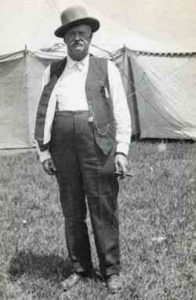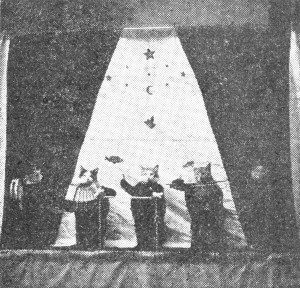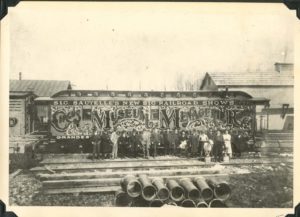
Sig Sautelle
George Satterly of Luzerne, New York was born in 1848 and began his career as a showman while enlisted in the Union Army during the Civil War learning ventriloquism. Starting out, he did his act while working as a wagon maker and was soon found by A.B Stowe’s Great American Circus. Satterly performed his act in their sideshow and later traveled with Barnum and Bailey Circus. After years on the road, he opened up his own circus in in Syracuse, New York in 1882 called Sig Sautelle’s Big Shows.
In an article from 1948 titled, Sig Sautelle: A Great Showan by John C. Kunzog, one of feline acts is described:
“…mention was made of Sautelle’s dislike for dogs. This hatred was an amazing antithesis to his love for cats. Any cat that strayed on the lot would be petted and fed by Sig. One of the most pleasing acts was Sig’s cat orchestra. Miniature band instruments were fastened to the paws of the cats, and with invisible threads, manipulated by Sautelle, the feline orchestra gave forth musical strains. It was, of course, Punch and Judy perspective, using felines for puppets. It was such acts as this, appealing to children and grown ups alike, that made the show popular with common people.”

Sig Sautelle Cat Act
The following comes to us from the Circus Historical Society:
“Up to this time he was known by his true name – George Satterlee – but with the launching of his Punch and Judy show he planned to adopt the cognomen of ‘Signor.’ But somehow, his face lacked the Latin characteristics to go with the name, and the second syllable of “Signor” was never pronounced, and thus it was that the master showman was known as Sig Sautelle.
He gave his show in halls as well as opera houses and the plaudits of amusement seekers brought him to the attention of A. B. Stowe, who induced him to join the A. B. Stowe’s Great American Circus and perform his act in the sideshow. Later he traveled with Barnum and Bailey.
For eight years he trooped around the country. In the summer with the circus, in the winter months he gave his exhibitions indoors, saving his money, and in 1882 he realized his great ambition circus of his own – Sig Sautelle’s Big Shows – which opened at Syracuse, N. Y. The show traveled by canal boats and played towns along the Erie, Chemung, Seneca and Champlain Canals. Two boats were used, one accomodating the performers and other employees, fitted with plenty of staterooms, kitchen and large dining hall. The second boat carried the animal cages, horses, wagons, canvas, seats and other equipment.
Winter did not deter the redoubtable Sig from continuing his quest for riches. He froze his boats in the canal at Syracuse and turned them into beer saloons. To keep down the overhead on his circus livestock during the winter season, it is stated that Sig hired out his horses and wagons to the City Fathers of Syracuse for municipal work.
After five years of plying the waterways, Sig viewed the progress made in road building with an approving eye and in 1887 he opened the season as a wagon show. This new mode of transportation opened up new horizons; his route no longer was circumscribed by canal towpaths, he could take the fork to the right or to the left, wherever the prospect seemed brightest. It also allowed for a longer season. A certain share of the profits were invested in new show equipment and by 1891 he had 225 people on the payroll; boasted two elephants, 14 cages of animals and 1,50 heads of horses, and ponies.
Sautelle had planned to make Syracuse, N. Y., his winter quarters, and for many years was located in an old car barn on Grape street. Near the turn of the century, the building was sold and Sautelle was forced to vacate the premises in the dead of winter.
Sig scouted about a few days and came back with the news that he had purchased a brick hotel and farm at DeRuyter, N. Y., a small village about 20 miles southeast of Syracuse.
The equipment was loaded and the wagons rolled through hubdeep snow toward the new home. It required two days to make the short trip.
The hotel was renamed Sautelle House, and while no one was refused, no effort was made to attract transient guests. The circus folk were just becoming contented in their new environment when friction developed over a large dog, resulting in the removal of the show quarters from DeRuyter.
Sig Sautelle had an aversion to dogs. His antipathy toward the canine world was un-explainable. He would tolerate no dogs in his circus, and no performer, no matter how valuable, was allowed to have a dog while with the show.

Sig Sautelle’s New Big Railroad Shows train – George Piercy collection
One of the residents of DeRuyter had a large dog that not only nettled, Sautelle, but frightened him as well. Sig wanted to buy the animal to have it killed or placed on some farm, where he would not see it again. The owner, learning of Sautelle’s antipathy for dogs, had a similar regard for “circus folk” and refused to part with the dog, but delighted in strolling with the animal when he knew he would meet with Sautelle, especially evenings when everyone in the village sauntered to the depot of the Lehigh Valley railroad to see the trains come in. The dog and his master were always there to silently taunt Sig.
The upshot of the affair was the removal from DeRuyter to Homer, N. Y., 20 miles to the south. Here, too, Sig purchased a hotel for the housing of his help. Homer was the locale of the famed David Harum story, and Sautelle called his hostelry the David Harum House, a name that still clings to the tavern.
The circus continued to grow in size and popularity and when the show closed at Tully, N. Y., September 28, 1901, the announcement was made that the following season the show would be on rails, using 2 sixty-foot cars for transportation; the menagerie to consist of 14 cages and the circus would have four elephants.”

